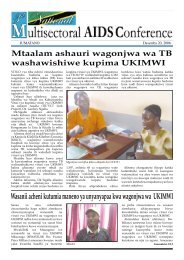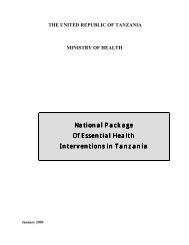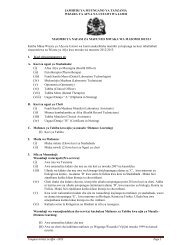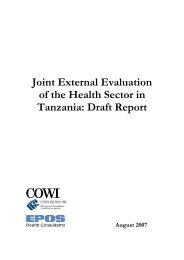Environmental and Social Management Framework for Tanzania ...
Environmental and Social Management Framework for Tanzania ...
Environmental and Social Management Framework for Tanzania ...
You also want an ePaper? Increase the reach of your titles
YUMPU automatically turns print PDFs into web optimized ePapers that Google loves.
<strong>Environmental</strong> Impact Assessment <strong>and</strong> Audit Regulations would prescribe the<br />
conduct <strong>for</strong> <strong>Environmental</strong> Impact Assessment. However, these instruments may not<br />
sufficiently provide <strong>and</strong> support the screening process <strong>for</strong> identification, assessment<br />
<strong>and</strong> mitigation of potential localized impacts, where the project details <strong>and</strong> specific<br />
project sites are not yet known, as required by the Bank. This ESMF provides<br />
mechanisms <strong>for</strong> ensuring that potential environmental <strong>and</strong> social impacts of the<br />
Regional Health Systems Strengthening <strong>and</strong> TB Support Project activities are<br />
identified, assessed <strong>and</strong> mitigated as appropriate, through an environmental <strong>and</strong><br />
social screening process. This ESMF would there<strong>for</strong>e, complement the participating<br />
countries’ EIA procedures <strong>for</strong> meeting the environmental <strong>and</strong> social management<br />
requirements. The ESMF complements <strong>and</strong> is in line with the World Bank<br />
Operational Policies <strong>for</strong> environmental management of projects where specific<br />
details are not yet known.<br />
1.7 POTENTIAL USERS OF THE ESMF<br />
The ESMF has been prepared as a reference manual <strong>for</strong> use by key stakeholders to<br />
be involved in the planning, implementation, management <strong>and</strong> operation of the<br />
proposed Regional Health Systems Strengthening <strong>and</strong> TB Support Project. As a<br />
reference material, the ESMF would be useful to the following project key<br />
stakeholders, ministries <strong>and</strong> departments in the participating countries:<br />
• Ministries responsible <strong>for</strong> Health <strong>and</strong> <strong>Social</strong> Welfare<br />
• Participating Countries of the Regional Health Systems Strengthening <strong>and</strong> TB<br />
Support Project who may update the ESMF as necessary;<br />
• Funding <strong>and</strong> Donors Agencies;<br />
• Town & Country Planning Committees <strong>and</strong> District Executive Committees in<br />
the selected cities <strong>and</strong> districts of the participating countries;<br />
• Politicians <strong>and</strong> Local Traditional Leaders;<br />
• Senior Government officials responsible <strong>for</strong> policy making <strong>and</strong> development<br />
planning; <strong>and</strong><br />
• National Healthcare waste management Programmes <strong>for</strong> the participating<br />
countries<br />
1.8 APPROACH AND METHODOLOGY FOR ESMF PREPARATION<br />
One of the key objectives of the ESMF is to provide a screening process <strong>for</strong> potential<br />
environmental <strong>and</strong> social impacts <strong>for</strong> planned future project activities of the Regional<br />
Health Systems Strengthening <strong>and</strong> TB Support Project <strong>and</strong> to recommend generic<br />
management <strong>and</strong> monitoring plans <strong>for</strong> addressing the potential negative impacts. In<br />
the development of this ESMF a high degree of consultation with various key<br />
stakeholders was employed. The rationale of these extensive consultations was to<br />
solicit views of a cross section of key stakeholders including key officials of<br />
Government Departments involved in the project <strong>and</strong> the EIA process.<br />
The strategies <strong>for</strong> executing this assignment followed the six steps listed below:<br />
• review of documents <strong>for</strong> project concept <strong>and</strong> implementation processes <strong>for</strong><br />
the proposed project activities;<br />
• review of other relevant literature <strong>and</strong> government regulations <strong>for</strong><br />
environmental management <strong>and</strong> preparation of EIAs;<br />
16







